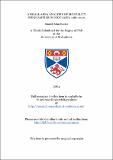Files in this item
A small area analysis of mortality inequalities in Scotland, 1980-2001
Item metadata
| dc.contributor.advisor | Boyle, Paul | |
| dc.contributor.advisor | Flowerdew, Robin | |
| dc.contributor.author | Exeter, Daniel J. | |
| dc.coverage.spatial | xvii, 352 p. | en_US |
| dc.date.accessioned | 2018-06-14T12:06:03Z | |
| dc.date.available | 2018-06-14T12:06:03Z | |
| dc.date.issued | 2004 | |
| dc.identifier.uri | https://hdl.handle.net/10023/14059 | |
| dc.description.abstract | This thesis examines the changing patterns of mortality in Scotland, with particular emphasis on whether there are widening mortality inequalities among small areas in Scotland. The annual number of deaths in Scotland has decreased steadily since the 1950s, yet mortality rates in Scotland are amongst the highest in Europe for many causes. Furthermore, mortality from some causes, such as suicide, has been increasing over time, particularly among young adults. Evidence suggests that inequalities in mortality have widened over time in Scotland, despite substantial investment in policies aimed at reducing inequalities. Therefore, it is important to seek geographical clues that might help explain what causes these high mortality rates. The changing patterns in Scottish mortality between 1980 and 2001 were examined for small areas, created by the author, known as Consistent Areas Through Time (CATTs). These areas have the same boundaries for each census, so that direct comparisons over time are possible. In this study, CATTs have been used to investigate three aspects of the mortality gap in Scotland. First, the widening mortality gaps between 1980-1982 and 1999-2001 are examined for the total population and for premature mortality (<65 years). Second, the influence that geographic scale and deprivation have on the relationship between population change and premature mortality are assessed. Third, suicide inequalities are examined for the younger (15-44 years), older (45+) and total population, using mortality ratios and statistical modelling. The research found that inequalities in premature mortality (<65) have widened for all causes of death studied, particularly for suicide. The negative association between mortality and population change was affected by geographic scale, but this relationship could not be fully explained by deprivation. Small area analyses found that the Highlands and Islands had higher suicide rates than elsewhere in Scotland for males, but not females, when social variables were controlled for. | en_US |
| dc.language.iso | en | en_US |
| dc.publisher | University of St Andrews | |
| dc.subject.lcc | HB1417.E8 | |
| dc.subject.lcsh | Mortality--Scotland--Statistics | en |
| dc.subject.lcsh | Mortality--Scotland--Regional disparities | en |
| dc.subject.lcsh | Mortality--Economic aspects--Scotland | en |
| dc.subject.lcsh | Poor--Health and hygiene--Scotland | en |
| dc.title | A small area analysis of mortality inequalities in Scotland, 1980-2001 | en_US |
| dc.type | Thesis | en_US |
| dc.contributor.sponsor | Overseas Research Students Awards Scheme (ORSAS) | en_US |
| dc.type.qualificationlevel | Doctoral | en_US |
| dc.type.qualificationname | PhD Doctor of Philosophy | en_US |
| dc.publisher.institution | The University of St Andrews | en_US |
This item appears in the following Collection(s)
Items in the St Andrews Research Repository are protected by copyright, with all rights reserved, unless otherwise indicated.

